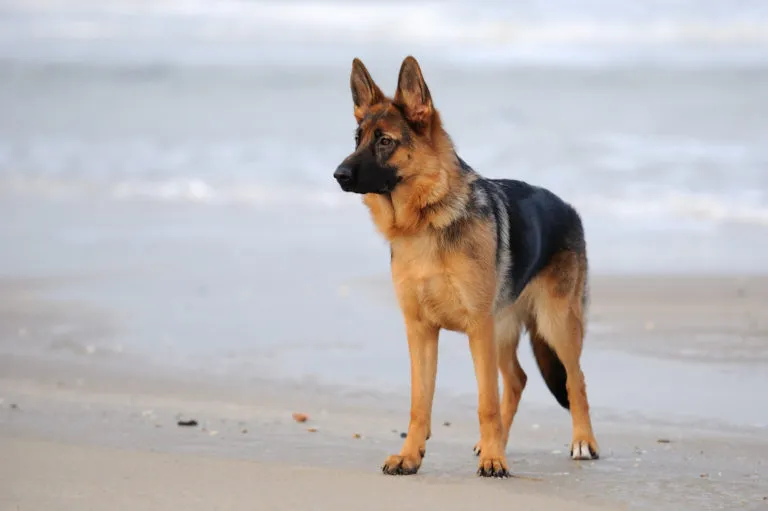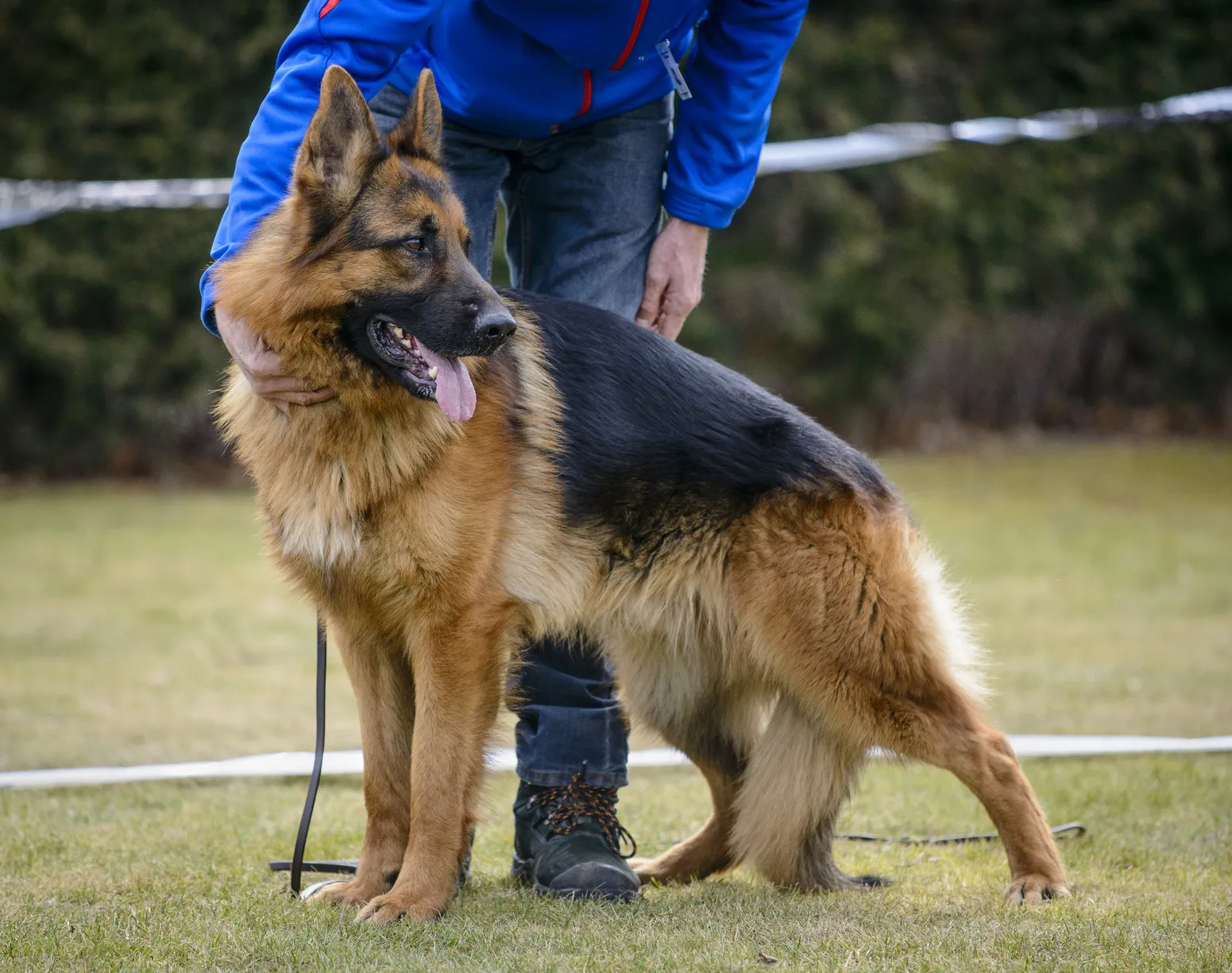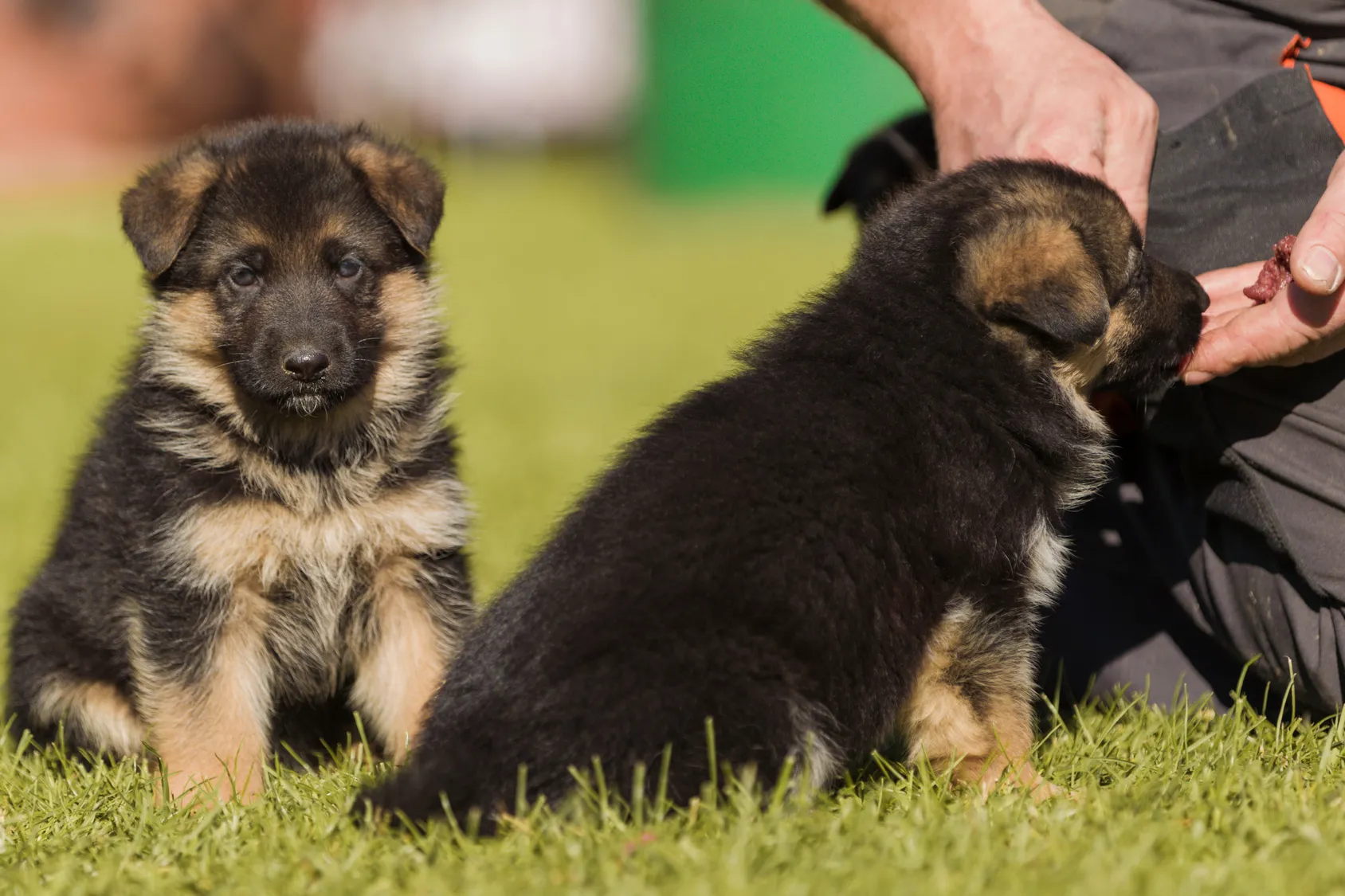Beagle
The Beagle's short legs can be deceiving – this medium-sized dog keeps you on your toes and is always full of surprises! This friendly breed is active, fearless and extremely clever.
The German Shepherd is one of the most popular utility dog breeds in the world, though the willing-to-learn and people-focused nature of these versatile dogs also makes them suitable for family life.

Hardly any other dog breed can be deployed as diversely as the German Shepherd. Originally bred as a shepherd dog to protect and guard sheep, the German Shepherd is nowadays found as a service and guard dog for the police, military and customs, a rescue and therapy dog, an avalanche search dog and a guide dog. It is the leading utility dog breed not just in Germany, its country of origin, but throughout the rest of the world too.
Neither man nor machine can replace these courageous, tenacious and reliable dogs in their line of work. Their herding instincts, endurance and self-confidence are legendary. Thanks to their high intelligence, willingness to learn and huge will to work, they accept new challenges in a flash and are therefore suitable for almost every task intended for them. What’s more, the German Shepherd is very people-focused and a constant loyal companion to its owner. It is mainly the combination of robustness, will to work, reliability and obedience that makes the German Shepherd so popular and predestined to take on a huge range of tasks.
The German Shepherd’s reliability and loyalty towards humans has made it a popular family dog too. As long as they are well trained and stimulated, these dogs in fact make excellent partners and companions very well suited to family life. Well-socialised German Shepherds are very fond of children and compatible with other pets too. However, the requirement for life as a family dog is that they are mentally and physically stimulated. Dogs that do not get enough activity and whose urge for exercise and will to work is ignored develop bad habits, which are alien to this essentially easygoing pedigree breed. They get nervous and overly watchful and are difficult to control in day-to-day life. On the other hand, physically and mentally stimulated German Shepherds enrich any family as playmates, sporting buddies and incredibly loyal guardians.
With males reaching a shoulder height of between 60 and 65cm and females 55 to 60cm, the German Shepherd is a medium to large-sized breed. Its well-proportioned body is testament to its life as a working and utility dog. It is strong and muscular though still appears athletic and agile. It will reject any kind of slowness and has a powerful, far-reaching gait that shows its immense endurance.
The wedge-shaped head is proportioned in line with the body and ends with a straight nasal bridge and a black nose. Not least its complete scissor bite made up of 42 teeth will impress its counterparts. The upright, forward-facing prick eyes and dark, slightly slanted eyes give the German Shepherd a constantly alert and attentive expression.

For a long time, only dogs with fur made up of top hair were permitted by the FCI breed standard, in which the German Shepherd was listed under number 166 in the group Sheepdogs and Cattledogs. The top hair should be straight, firmly in place and strengthened by a dense undercoat that reliably protects these dogs from the snow, rain and cold weather.
The long stock-hair type was not accepted in the FCI standard until 2008. The long, soft stock hair forms abundant “flags” and “trousers” around the ears, limbs and tails and does not lie close to the body. The very furry throat bears a typical mane. The colours of the top hair or long stock hair are black with brown, yellow or light grey markings, monotone black or wolf grey or grey with brown markings.
Although there are occasionally white German Shepherd puppies with some litters, the FCI standard considers the colour white to be a defect. In 1968, the Shepherd Dog Club of America responsible for the American Kennel Club standard finally followed suit. Nowadays, the only exception is the Canadian Kennel Club, which still accepts white German Shepherds in its studbook. Since 1911, the FCI has listed the White Shepherd as an independent breed under the name Berger Blanc Suisse (White Swiss Shepherd). However, white German Shepherd puppies may not be paired with these Swiss dogs and can therefore not be registered as such either.
In principle, the German Shepherd has got bigger and bulkier as the breed has developed. Critics complain that this form no longer has much in common with the original type, which was slightly lighter and less muscular though more agile. This conflict amongst breeders ultimately led to there being a differentiation between two different breeding lines nowadays: on the one hand, breeding for size or aesthetics with a somewhat bulkier body and a sloped back, and on the other hand performance breeding, which favours a lighter type and primarily values good utility dog qualities.
The German Shepherd’s ancestors were presumably to be found in Germany as early as the 7th century. These stock-haired dogs already had a very broad range of tasks even then. Although their main purpose was guarding and herding sheep, they were also to watch and protect the shepherd’s belongings at the same time.
However, the history of the German Shepherd as we know it today only officially commences at the end of the 19th century. In 1871, the Prussian cavalry captain Max von Stephanitz, nowadays considered the founder of the breed, started targeted breeding of these diverse dogs.
Stephanitz had remarkable success with the male Hektor von Linksrhein, which he renamed Horand von Grafath in 1898 after making the purchase. Horand was the first dog entered in the studbook of the newly founded “Verein für Deutsche Schäferhunde [Association for German Shepherds]” (SV). Stephanitz focused all of his breeding efforts on Horand and his brother Luchs von Sparwasser. Both these males and the female Mari von Grafrath are nowadays considered the founding progenitors of the German Shepherd breed, with most dogs able to be traced back to their line.
Stephanitz’s breeding objective was clearly defined and focused on a versatile utility dog, with breeders having precise expectations regarding their nature and working qualities. The virtues of courage, loyalty, obedience, endurance and robustness make the German Shepherd world-famous and one of the most popular service dog breeds in many countries for bodies such as the police and military. During the First and Second World War, these qualities were stylised as “German virtue”, with the German Shepherd becoming a symbol of the national socialist ethos. In the wake of anti-German resentment abroad, the British Kennel Club changed the breed name to Alsatian Wolf Dog or at a later stage simply to Alsatian Dog in order to avoid the word “German”. This change of name wasn’t reversed until 1977.
Nevertheless, the German Shepherd was a sought-after dog of war by the Allies as well as the Germans, though it sadly reached notoriety due to being deployed in concentration camps and as a loyal companion of Adolf Hitler. Numerous national socialist propaganda photos show Hitler with his German Shepherd called Blondi. Despite this instrumentalisation and severe decimation due to the Second World War, the breed prevailed following the end of the war and soon became one of the world’s most in-demand utility dog breeds again. With the transformation of many breeds into family dogs, the German Shepherd became more and more popular in this category too.
Unfortunately the number of diseases typical of the breed increased as its population grew, which is when hip dysplasia (HD), nowadays affecting many dog breeds, was first identified as affecting the German Shepherd. Another joint disease constantly affecting the breed is elbow dysplasia (ED), as well as degenerative lumbosacral stenosis (DLSS), also known as Cauda equina syndrome, which leads to signs of paralysis. In addition, the German Shepherd is increasingly affected by ocular diseases and allergies.

Genetic tests on animals to be deployed for breeding can reduce the risk of such hereditary diseases. There is now what is known as a breed value with information on the extent to which a puppy is predisposed to suffer from a certain disease. Dogs with a particularly strong genetic predisposition are excluded from the breeding process. If you’re interested in a German Shepherd puppy, you should definitely clarify if all recommended tests have been carried out and “passed” by the breed. The requirement is that you buy your puppies from a responsible breeder who invests plenty of time and money in the health of their dogs and willingly gives you information. It goes without saying that an all-round healthy and well-monitored puppy isn’t available at a bargain price. Compared to other breeds though, a price of around 800 euros for a pedigree German Shepherd puppy is still rather low.
Before you choose a breeder, you should be clear on the purpose for which you wish to buy a German Shepherd. Most breeders are specialised in different lines and encourage different qualities amongst their breeding animals. After all, the prominence of their protective instinct or urge to work depends not least on the breed. Find out in advance if the breeder is offering an aesthetic or purely performance breed and choose the breeding site best suited to your expectations and requirements. If you want to keep your canine purely as a family dog though, you should be aware that even German Shepherds from purely aesthetic breeds are still very willing to learn, have a strong urge for activity and definitely won’t be satisfied with short walks around the block.
Your dog’s activity level determines what food is its most suitable option. It’s clear that dogs that spend several hours a day “working” and get plenty of exercise have different energy requirements to family dogs that generally always have long periods of rest. In principle though, all dogs regardless of the tasks they carry out should receive protein, minerals and vitamins for healthy development. Meat is the most important protein source for dogs, should make up around 70% of the food and should be given to your dog pre-prepared, self-cooked or raw (keyword BARF). 20-30% fruit and vegetable content is recommended to provide your dog with further important vitamins and minerals. However, too much grain or sugar have no place in a healthy canine diet.
Since German Shepherds tend to develop joint problems like many large dog breeds, it’s important to prevent them from growing too quickly during the first few months. As studies demonstrate, hip dysplasia depends both on genetic predisposition and the type of food. Too much fat and food too rich in calories accelerate the already fast growth of German Shepherd puppies and can still cause joint problems even in old age. Hence, get a precise dietary recommendation from your breeder and make sure you give your puppy appropriate food. In addition, the breeder will advise you not to overexert your puppy with too much exercise. You should completely avoid climbing stairs at first. Natural rest periods support the healthy development of the bones and joints.
Along with a good diet and species-appropriate housing, adequate grooming also forms part of a healthy canine life. The German Shepherd’s stock hair is very low-maintenance, although regular brushing or combing are necessary to maintain a healthy texture. Regular deworming and vaccinations are also essential. Furthermore, you should keep a particularly close eye on your dog’s ears, eyes and claws, which regularly need cleaning and trimming and should be checked by the vet if there are any changes.
If you decide to make a German Shepherd part of your family, you should think in advance about its housing arrangements, as well as grooming and nutrition. German Shepherds are primarily utility dogs and like to be “needed” as such within a family. Sufficient physical and mental stimulation is essential for living in harmony with your dog. As a German Shepherd owner, you should have time and inclination to go on long walks and cycling trips together, as well as providing species-appropriate activity in the form of dog sport or training for your exercise-loving dog that enjoys learning new things.
Thanks to its versatility, the German Shepherd is keen on almost all types of dog sports and is suitable for both agility and dog dancing as well as obedience. Its outstanding sense of smell makes it ideal too for tracking work or man-trailing. Training as a rescue dog, guard dog or for herding is recommended for German Shepherds kept as family dogs too. Whatever sporting and mental activity you choose, you will soon observe the positive effects for your dog and your relationship with one another. Dogs with a sufficiently trained body and mind are able to enjoy rest and relaxation periods more and are also more receptive to training. If you have enough time for your German Shepherd’s training and fitness, you will be rewarded with an extremely lovable, sporty, tenacious, obedient and loyal family dog.
The Beagle's short legs can be deceiving – this medium-sized dog keeps you on your toes and is always full of surprises! This friendly breed is active, fearless and extremely clever.
The Golden Retriever is still one of the most popular dog breeds, especially with families. It is defined not just by its docility, but shows numerous other qualities too. Read in the following article everything you need to know about the Golden Retriever.
The German Shepherd is one of the most popular utility dog breeds in the world, though the willing-to-learn and people-focused nature of these versatile dogs also makes them suitable for family life.